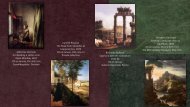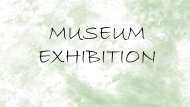You also want an ePaper? Increase the reach of your titles
YUMPU automatically turns print PDFs into web optimized ePapers that Google loves.
Joseph Mallord William Turner<br />
Self‐Portrait<br />
c. 1799<br />
Oil on canvas, 74 x 58 cm<br />
Tate Gallery, London<br />
Joseph Mallord William Turner was<br />
born April 1775, Maiden Lane,<br />
Covent Garden, London. His father,<br />
William Gay Turner moved to<br />
London around 1770 to follow his<br />
father’s trade, where he eventually<br />
became a barber and wig‐maker. His<br />
mother came from a line of<br />
prosperous London butchers and<br />
shopkeepers.<br />
Turner was sent to stay with uncles<br />
at Brentford in 1785 and<br />
Sunningwell in 1789, and to<br />
Margate in 1786 where he also<br />
attended school due to his mother,<br />
Mary Marshall, mental disturbance.<br />
At home his father encouraged his<br />
artistic talent. In December 1789, young Turner entered the Royal<br />
Academy Schools, where he progressed from the Plaister Academy,<br />
drawing from casts of ancient sculpture, to the life class in 1792. By<br />
1794, with his friend Thomas Girtin, he attended the evening ‘academy’<br />
accommodated by Dr Thomas Monro at his house in the Adelphi, they<br />
both studied in copying works by other artists.<br />
Landscapes and antiquarian topography were<br />
popular during this period. In the following years he<br />
advanced in the styles of the Old Masters and made<br />
rapid progression in their techniques. He was<br />
favoured by many which led to big commissions by<br />
patrons like Richard Colt Hoare, William Beckford<br />
and Duke of Bridgewater. In 1819, Turner visited<br />
Italy. The first time he travelled to Venice, Rome and<br />
Naples where he was inspired by Canaletto.<br />
His father's death in 1829 affected him and his<br />
artwork, resulting with depression. His studies<br />
showed that he was a Romantic landscape painter,<br />
watercolourist and printmaker, which were said to<br />
have laid the foundation for Impressionism due to<br />
their careless brushstrokes in some of the paintings.<br />
He died in the house of his mistress Sophia Caroline<br />
Booth in Cheyne Walk, Chelsea on 19 December<br />
1851. He was recognised as "the painter of light“.<br />
His last words were suggested to be "The sun is<br />
God" before passing away.





